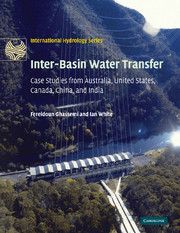Book contents
- Frontmatter
- Contents
- Foreword
- Overview and Scope
- Acknowledgements
- List of Abbreviations
- Part I The Challenges
- Part II Inter-basin Water Transfer in Australia
- 3 Land and water resources of Australia
- 4 The Snowy Mountains hydro-electric scheme
- 5 Inter-basin water transfer from coastal basins of New South Wales
- 6 The Bradfield and Reid schemes in Queensland
- 7 Three schemes for flooding Lake Eyre
- 8 The Goldfields pipeline scheme of Western Australia
- 9 Supplying Perth, Western Australia with water: the Kimberley pipeline scheme
- 10 Other schemes in Australia
- Part III Inter-basin Water Transfer in Other Selected Countries
- Part IV Appendices
- Glossary
- Index
- References
4 - The Snowy Mountains hydro-electric scheme
Published online by Cambridge University Press: 05 November 2009
- Frontmatter
- Contents
- Foreword
- Overview and Scope
- Acknowledgements
- List of Abbreviations
- Part I The Challenges
- Part II Inter-basin Water Transfer in Australia
- 3 Land and water resources of Australia
- 4 The Snowy Mountains hydro-electric scheme
- 5 Inter-basin water transfer from coastal basins of New South Wales
- 6 The Bradfield and Reid schemes in Queensland
- 7 Three schemes for flooding Lake Eyre
- 8 The Goldfields pipeline scheme of Western Australia
- 9 Supplying Perth, Western Australia with water: the Kimberley pipeline scheme
- 10 Other schemes in Australia
- Part III Inter-basin Water Transfer in Other Selected Countries
- Part IV Appendices
- Glossary
- Index
- References
Summary
LOCATION
The Snowy Mountains area is located in the south-east corner of the State of New South Wales (Figure 4.1). It is the most elevated area of the continent and includes Australia's highest peak Mt Kosciuszko with an elevation of 2228 m. The average annual precipitation for most of the area ranges between 1200 mm to 1600 mm with small areas exceeding 2000 mm (Figure 3.2). Above an elevation of 1400 m, precipitation in winter often falls as snow and extensive areas are covered with a thick mantel. The major rivers of the area are:
The Snowy River, which originates at an elevation of 1770 m, drains the south-eastern part of the area along its 300 km length, and discharges to Bass Strait at Marlo (south-east of Orbost) in Victoria. One of its major tributaries is the Eucumbene River (see Figure 4.3).
The Murrumbidgee River, which drains the north-eastern corner of the area. Its major tributary is the Tumut River.
The River Murray, which has its source in the western part of the region.
The Snowy Mountains Hydro-electric Scheme, which diverted flows from the Snowy and Murrumbidgee rivers is located in the Snowy Mountains area.
HYDROLOGY
The Snowy River has an average annual natural flow of 1177 × 106 m3 at Jindabyne (see Figure 4.3) and 2150 × 106 m3 at its mouth. The Snowy catchment above Jindabyne represents approximately 15 percent of the total area of the catchment, but because of the high precipitation, it contributes approximately 50 percent of the total annual run-off of the catchment.
- Type
- Chapter
- Information
- Inter-Basin Water TransferCase Studies from Australia, United States, Canada, China and India, pp. 91 - 106Publisher: Cambridge University PressPrint publication year: 2007

